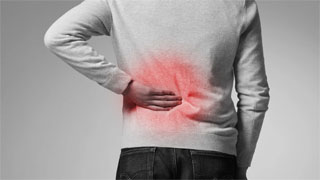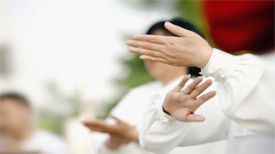
Nowadays, due to excessive workload or intense study, more and more young people suffer from lumbar muscle strain, which is no longer an exclusive disease of the elderly. The main reason is lack of exercise.
Lumbar muscle strain refers to a general term for all lumbar muscle strain related diseases characterized by soreness, swelling, and pain in the waist caused by prolonged or repeated stretching and bending of the waist muscles, including lumbar transverse process syndrome, lumbar fascia pain syndrome, and lumbar sacral ligament injury. The pathogenesis is that muscles, like rubber bands, maintain the same posture for a long time or stretch beyond their capacity, causing fatigue, injury, and pain. Pain leads to muscle spasms, squeezing blood vessels, and exacerbating the damage.
Lumbar muscle strain, also known as chronic muscle strain, is a chronic inflammatory strain disease of the back muscle fascia caused by external pulling, injury, or twisting of the waist and back. It includes both acute and chronic types. Acute lumbar muscle strain is commonly seen in sprains of the waist, such as when carrying heavy objects or sneezing, and requires bed rest for 1-2 weeks, even wearing waist circumference, to prevent it from becoming chronic. Chronic lumbar muscle strain is often caused by long-term improper posture, sitting for long periods of time, standing for long periods of time, bending over to carry heavy objects, or long-term fatigue in the waist, mainly manifested as soreness, swelling, and weakness in the waist, and pain during acute attacks.
The causes of lumbar muscle strain are closely related to daily life, and bad habits are the trigger. For example, if acute lumbar sprain is not treated in a timely manner or handled improperly; Long term repeated excessive lumbar exercise and overload; Related to climate and environment, low temperature or high humidity can easily trigger or worsen; Inconsistent movements when lifting heavy objects; Excessive force when carrying heavy objects, pushing and pulling heavy objects; Poor posture, long-term incorrect sitting and standing posture, excessive force or sudden external impact, and tearing of the sacral spine muscle insertion point when bending down to lift heavy objects; Falling and slipping while walking on slippery ground.
The symptoms of lumbar muscle strain include soreness or swelling in the lower back, partial stabbing or burning pain, aggravated during exertion, relieved during rest, relieved during movement and changing positions, and aggravated by excessive activity; Unable to persist in bending down to work, often forced to stretch or punch the waist to relieve pain; There are tender points in the waist, mostly located at the sacral spine muscle, posterior iliac spine, sacral posterior sacral spine muscle insertion point, or lumbar transverse process; There are no abnormalities in the appearance and movement of the waist, and a few patients have slightly limited waist movement; Repeated attacks can accelerate lumbar degeneration, causing lumbar disc herniation or lumbar spinal stenosis. Its clinical manifestations are slow onset, chronic pain without obvious causes or after fatigue, fixed tender points in the pain area, percussion can alleviate pain, unilateral or bilateral sacral spiny muscle spasms, possible history of spinal kyphosis, lateral processes, or long-term sitting, bending, and weight-bearing, back pain, lumbar weakness, and accompanying lumbar movement disorders.
There are four main adverse factors that can cause lumbar muscle strain: long-term excessive weight-bearing, spinal structural instability, long-term bending, and improper treatment of lumbar injuries.
There are some common misconceptions about lumbar muscle strain: it is believed that only manual laborers will suffer from lumbar muscle strain, but in fact, prolonged sitting posture, incorrect posture, and lack of exercise may also lead to it; Believing that it is only related to age, in fact, it can occur at any age group; It is believed that only vigorous exercise can cause it, but in fact, maintaining the same posture for a long time, repetitive activities, and incorrect posture can also damage waist health.
The treatment of lumbar muscle strain should first improve blood circulation. Massage, traction, local diathermy, iontophoresis, ultrashort wave, audio frequency and other methods can be used to relieve muscle spasm, and acupuncture and moxibustion and traditional Chinese medicine can also be used. Other treatment methods include self-care therapy, such as proper rest, correcting poor posture, and training waist muscle strength; Appropriate functional exercises, such as waist and back muscle exercises; Drug therapy, using anti-inflammatory and analgesic drugs, as well as traditional Chinese medicine that soothes tendons and promotes blood circulation. Non steroidal anti-inflammatory drugs, local muscle relaxants, or sedatives can be used when the pain is obvious; Closed therapy is effective for patients with fixed tender points; Surgical treatment is suitable for cases where non-surgical treatment is ineffective. The cure criteria are symptom disappearance and functional recovery, while the improvement criteria are reduced back pain and restricted spinal movement.
Preventive measures for lumbar muscle strain include exercising the lumbar muscles, such as walking backwards, practicing yoga, jogging, twisting the waist, and doing swallow flying exercises. For office workers who sit for long periods of time, they should do regular chest expansion exercises; Pay attention to keeping warm throughout the year, especially for women; Regulating and tonifying kidney yin and kidney deficiency; Choose a mattress with moderate thickness and moderate hardness; Choose a heel of appropriate height; Moderate sexual activity and take good contraceptive measures.
The rehabilitation training for lumbar muscle strain includes:
1. Pelvic oblique lifting exercise: Lying in a supine position, bending both knees, firmly clamping the buttocks, contracting the abdomen, pressing the lower back against the floor, raising the buttocks, can strengthen the gluteal and abdominal muscles, and reduce lumbar flexion.
2. Unilateral knee hugging exercise: Lie down, bend both knees, tightly clamp the buttocks, contract the abdomen, hold one knee close to the chest with both hands, restore to its original position, repeat 5 times, switch to the other knee, and pull the muscles behind the lower back and knee, as well as the muscles of the opposite hip.
3. Bilateral Knee Hugging Exercise: Lie flat and bend your knees, touch your chest with your knees, slowly embrace until your back stretches, repeat 5 times, and pull the muscles behind your lower back and knees to strengthen your abdominal and hip muscles.
4. Unilateral straight leg lifting exercise: Lie in a supine position, bend one knee, straighten and lay the other side flat, clamp both buttocks, contract the abdomen, lift the straightened lower limb, slowly lower it, repeat 5 times, and switch to the other limb. It can pull the muscles behind the lower back and knee to strengthen the abdominal and hip flexion muscles.
5. Waist Stretching Exercise: Lie prone and stretch your hands back to your hips, with your abdomen as the support point. Release your chest and lower limbs from the bed at the same time and relax. Repeat this exercise 5 times to enhance the strength of your waist muscles.


